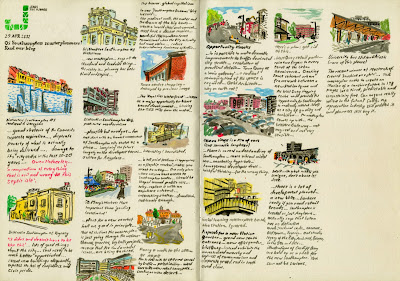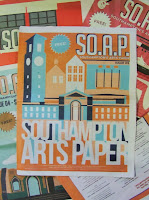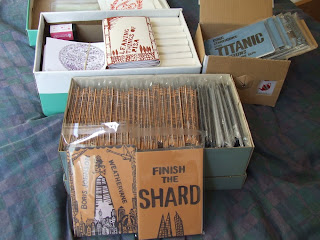 |
| Southampton's coat of arms. |
Here are the arms of my home town: three roses... red and white... hearty and unfussy.
Of course, the coat of arms is displayed here and there around the city. I remember staring at the one on the wall of the scout hut, with a strange woman rising out of the top of a castle. You can find several versions online (including
this page of postcards and cigarette cards). There are a few variations, chief of which is the ambiguity over which way round the red and white are, with the counter-charged roses. I've seen a description that left the matter open, to the effect of "three roses on a shield that is half red and half white": with three roses divided between two halves, you can go either way.
The official description,
here at the council's website, is more specific, and blames a seventeenth-century herald for drawing it up wrong and causing confusion. But is the figure on top a queen, or is she Lady Justice?
Recently it has been my turn to draw the coat of arms, on a Christmas card for the mayor. In the past I've made a few experiments, such as this linocut for a border, showing the elements of the coat of arms - the roses, lions, ships-on-a-sea, castle-on-a-mound and the "quene in her splendour" holding a sword and scales - all processing out from the shield.
 |
| My linocut of the figures from Southampton's crest. |
Drawing the whole crest involves working out the mantle (the fabric floating either side of the helmet) and getting the ships and lions right. Having spent seven months in Venice, and possibly spent a total of seven months of my life looking at books on heraldry, I might have hoped to be better at drawing lions by now! The final piece includes six in total - including the two that are smaller than a fruitfly, either side of the dome of the Royal Pier building.
The project took a few drafts and conversations, concerning what the mayor wanted and what I like drawing. We ended up with an array of buildings around the crest. I can't draw a bunch of local buildings without including Wyndham Court, and I was sad to have no space for the Harbour Lights cinema. The quarter-jacks of Holyrood Church are a favourite; the Red Lion pub's half-timbering is fun to draw [an aside: last night I enjoyed Jonathan Meades' 1998 programme on Worcestershire -
here is his barrage of half-timbering]. Buoys and container ships are another essential element.
The bridges circling the coat of arms are the Itchen Bridge, Cobden Bridge and the old Redbridge.
 |
| Southampton! The mayor's Christmas card for 2013. |
To finish, here are two of the various old badges available for the London & South Western Railway Company, using (without permission!) the arms of London (top left), Southampton (bottom left), Portsmouth (bottom right), Winchester (centre right) and Salisbury (top right).
Now it's time to make my own Christmas card, and I must live with the niggling fear that I got something wrong in the crest.
ADDENDUM!
(two days later)
 |
| Alterations! |

















































